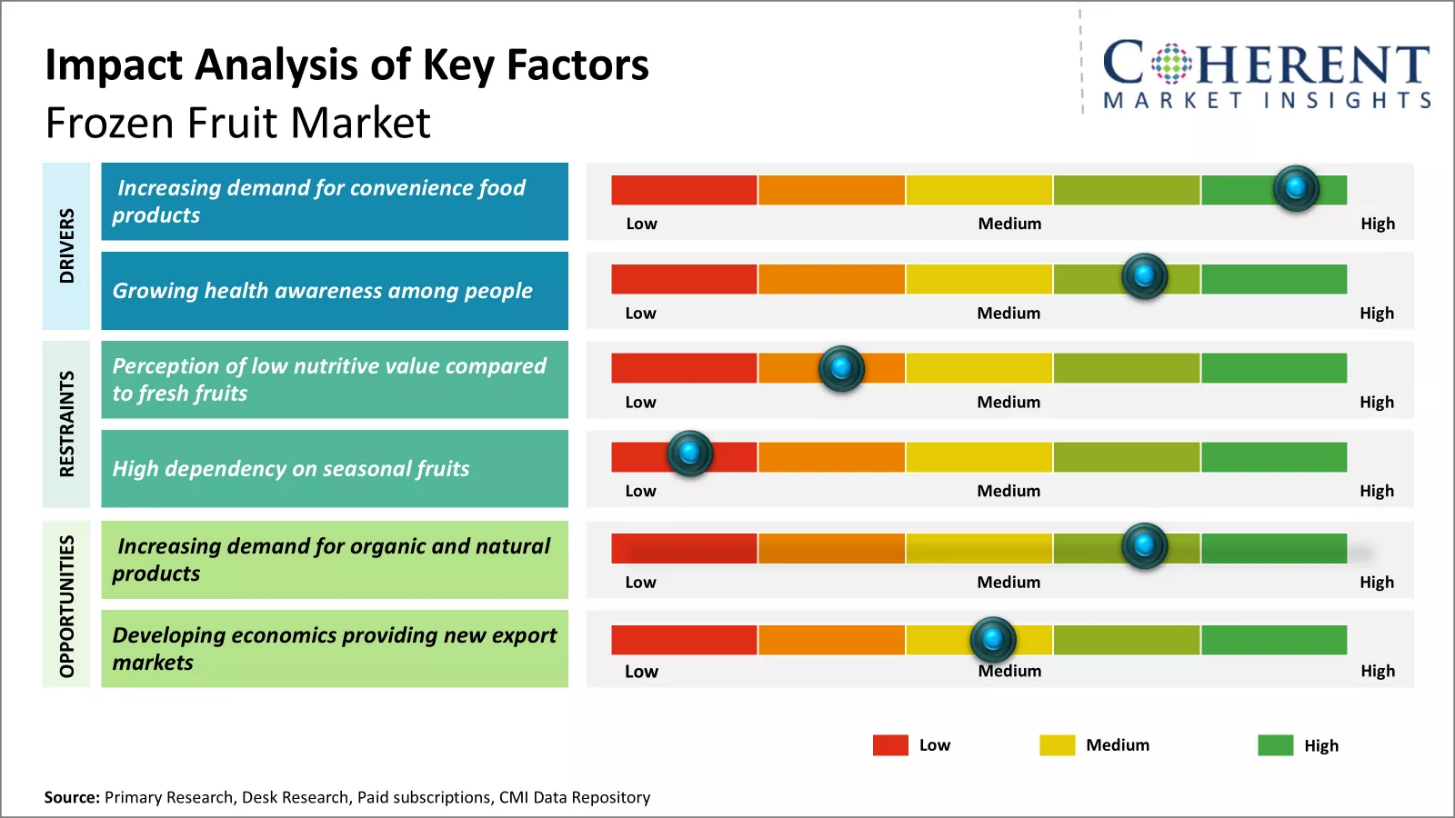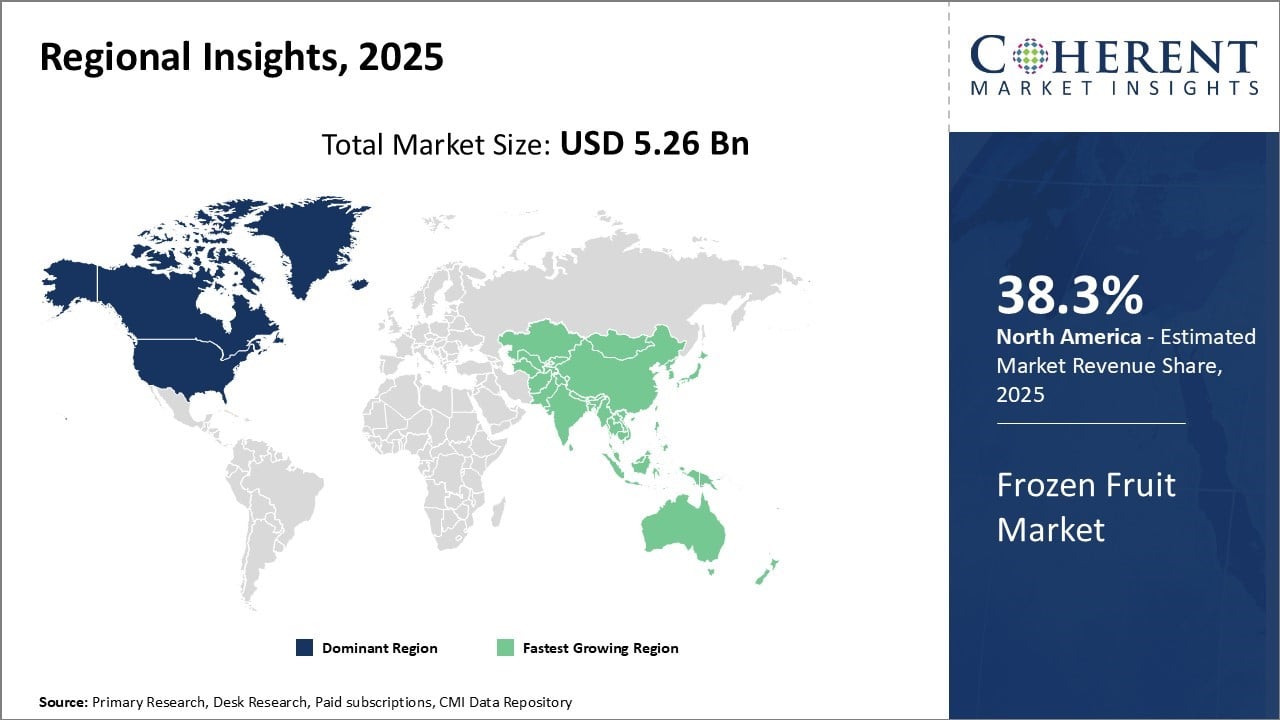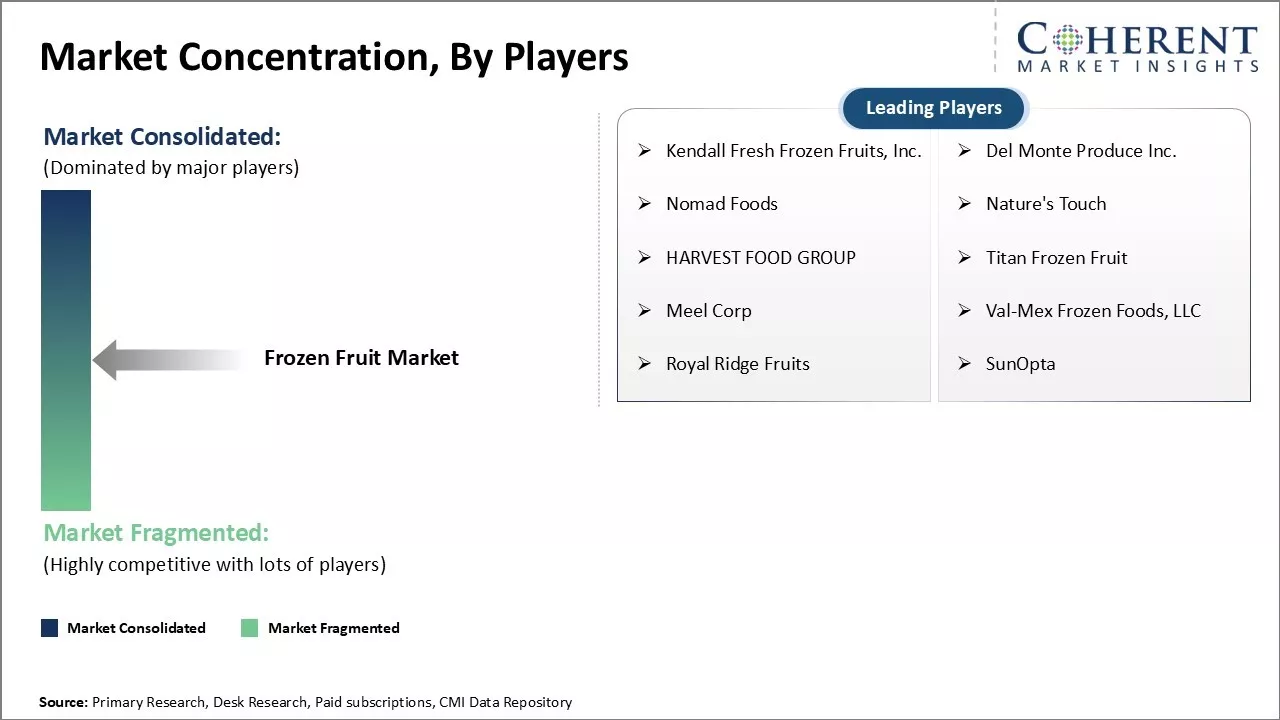The frozen fruit market is estimated to be valued at USD 5.26 Bn in 2025 and is expected to reach USD 8.29 Bn by 2032, exhibiting compound annual growth rate (CAGR) of 6.7% from 2025 to 2032. The market growth is attributed to factors such as the availability of different fruit varieties, longer shelf life as compared to fresh fruits, and hectic lifestyle of consumers that demand convenient food options.

To learn more about this report, Download Free Sample
The frozen fruit sector has been witnessing consistent growth over the last few years owing to rising health awareness, need for convenience food, and growing popularity of plant-based and clean-label diets. The market is expected to experience growth at a remarkable rate in the forecast period, led by growing applications in smoothies, functional drinks, dairy substitutes, and ready-to-eat foods. The longer storage life and retention of nutrients in frozen fruits over their fresh counterparts render them ever more appealing to consumers and food manufacturers alike.
|
Current Events |
Description and its impact |
|
Transition to New IQF & Flavor-Preserving Technologies |
|
|
AI-Powered Cold-Chain & Predictive Supply Systems |
|
Uncover macros and micros vetted on 75+ parameters: Get instant access to report
The worldwide market of frozen fruits is characterized by price stabilization over the recent years, even though history has seen it volatile. In 2024, world production of frozen fruit amounted to about 12 million tonnes and earned value of around 27.3 billion USD at export prices, down slightly (~–1.3%) from the level of 2022, which was 27.7 billion USD.
Export prices were around 2,535 USD/tonne, decreasing approximately 2.1%, whereas average import prices were about 2,497 USD/tonne, decreasing about 2.4% year-on-year.
Price differs considerably by type and country of origin. Berries (raspberries, blackberries, currants) are the most expensive at about 2,800–2,900 USD/tonne, while frozen strawberries are one of the lowest-priced at about 1,700–1,720 USD/tonne.
Drivers of pricing here are raw material cost fluctuations (weather, yields, tariffs), cold‐chain transport energy and logistics, and geopolitical disturbances such as war or inflation in producer nations like Russia and Ukraine. Consumers are still very sensitive to price; most markets are unwilling to pay premiums for frozen fruit over fresh options unless value is seen in convenience or health aspects.
Consumer interest in natural, clean-label, and organic frozen fruit is growing globally as health-oriented consumers increasingly demand minimally processed products free of artificial food additives, preservatives, and sweeteners.
The organic segment is already dominant—commanding an estimated 46% of revenue share in 2022—thanks to positioning against claims of purity, nutritional goodness, and sustainability. Health-conscious consumers, especially Millennials and Gen Z, value products that are seen as safer and more natural.
Organic frozen fruit is sold as "chemical-free, nutrient-dense alternatives" that support clean-eating and plant-based lifestyle trends. Companies are responding by highlighting organic certification, non-GMO status, and transparency in sourcing to bolster credibility with discerning consumers.
Concurrently, clean-label innovations continue to increase in popularity—firms are launching blends with superfruits or novel combinations, without additives, due to consumer demand for functional and premium frozen fruit. Retailers like Whole Foods and online plant-based food retailers have launched separate lines of organic frozen fruit (e.g., organic blueberries, mixed berries), driving typical growth within the category.
Geographically, adoption is highest in North America and Europe, where shoppers are both most mindful of organic certification and most likely to pay a premium price—usually 10–50% more—for perceived health and environmental gain (organic food premiums in general vary widely).
Consequently, the market for frozen fruit keeps growing—predicted to approach nearly USD 11.2 billion by 2032—thanks to organic and clean-label options spearheading value-added, profitable growth. Natural and organic frozen fruit demand is moving from niche to mainstream, influencing innovation, premiumization, and long‑term market opportunity in the worldwide frozen fruit market.
Artificial intelligence (AI) is transforming the worldwide frozen fruit industry with significant improvements in supply chain optimization, quality assurance, and forecasting demand. On the production side, AI-based visual inspection systems utilize computer vision and machine learning to automate the detection of flaws, ripeness, or deterioration of the fruit—reducing waste and increasing better quality product during the freezing and processing processes. This enables automated quality control versus manual inspections, enhancing consistency and safety.
In logistics, AI revolutionizes cold-chain handling by monitoring sensor readings (e.g. temperature, humidity) to provide ideal storage and transportation conditions. It real-time foretells and marks risks such as deviations in temperature, minimizing spoilage during transport and warehousing for frozen fruit products.
Route optimization with AI also improves delivery efficiency—orchestrating truck dispatch, eliminating cold-chain downtime, and reducing emissions through optimization in real-time. Demand forecasting is one of AI’s most transformative roles: machine learning models now analyze historical sales, weather patterns, promotional schedules, and even social media sentiment to predict seasonal spikes and adjust inventory proactively.
This granularity helps manufacturers and retailers reduce overstock and stockouts while aligning production to actual demand patterns. More advanced "demand sensing" systems combine multiple real-time data signals—leading to finer responsiveness in volatile markets.
With changing busy lifestyles and rising dual income households, convenience has become one of the top priorities for consumers. People are constantly looking for food products that can save their time and effort in the kitchen. Frozen fruits are perfectly positioned to capitalize on this demand as they can be stored and used as per convenience without much effort.
In April 2025, FNB News reported that frozen fruits are increasingly dominating supermarket freezers. Driven by fast-paced urban lifestyles, consumers are choosing frozen fruits as nutrient-rich, ready-to-use options that eliminate washing, peeling, and chopping. This shift caters especially to busy professionals, students, and families seeking convenient, health-forward nutrition.
One major opportunity for the frozen fruit market is the increasing demand for organic and natural food products globally. Consumers are becoming more health conscious and looking to limit consumption of foods with artificial preservatives, colors, flavors or genetically modified ingredients. Frozen fruits, which involve minimal processing and do not require the use of preservatives for longer shelf life, are well positioned to tap into this demand.
Frozen fruit producers can promote their products as a clean label and all-natural option. The market has also seen impressive growth of organic frozen fruits in recent years to meet the needs of health-focused consumers who prefer fruits grown without synthetic pesticides and fertilizers. This growing preference for organic and natural products is expected to drive significant growth for the frozen fruits market going forward.
In terms of type, citrus segment is estimated to contribute the highest market share of 36.1% of the frozen fruit market in 2025, due to their high demand and versatile uses. Oranges, lemons, limes and grapefruits are some of the popular citrus fruits frozen for consumption. Citrus fruits have a bright, tangy flavor that lifts the taste of both sweet and savory dishes. They are a rich source of vitamin C and contribute a refreshing flavor to smoothies, juices, desserts and more.
In terms distribution channel, online segment is estimated to contribute the highest market share of 57.1% of the frozen fruit market in 2025. Customers now expect a digital shopping experience on par with what they find in physical stores. This has propelled retailers and Consumer packaged goods (CPG) brands to establish robust online presences for frozen fruit products. Improvements in cold chain logistics by e-commerce giants ensure safe, reliable delivery of perishables directly to customers' doorsteps.

To learn more about this report, Download Free Sample
North America is expected to account for the greatest revenue share, with 38.3% in 2025. North America’s dominance in the frozen fruit market can be attributed to robust fruits production and strong market channels across countries like the U.S. Government initiatives to promote consumption of frozen produce have also contributed to market growth. Major players in the region such as Dole Food Company, Simplot and General Mills have reinforced their market presence through innovative product offerings and strategic acquisitions over the years.
The Asia Pacific exhibits the fastest growth driven by rising health consciousness and increasing per capita income in populous nations like India and China. Changing lifestyles and rising preference for convenience foods have boosted demand for frozen fruits. Large fruit production bases and improving cold chain infrastructure are helping drive market penetration. Key regional players including Del Monte and Huber's Fruit Plus have intensified their focus on the Asia Pacific market.
The U.S. market is characterized by high fruit sourcing capabilities and strong distribution networks of leading brands dominating retail shelves. Companies including Dole Food Company continue to leverage their scale to deliver innovative new products.
China's market growth is supported by government measures to modernize agriculture and food processing sectors. Regional players such as Yantai North Andre Juice are expanding operations to meet rising urban demand for frozen fruits.
India market continues to lead South Asia with its vast production base and emerging middle class. Companies like Del Monte focus on private label offerings and partnership with e-tailers to boost outreach.
Although Brazil faces export challenges, companies like Simplot are expanding in Latin America through tailored product ranges designed for the regional palate. Brazil's market retains opportunities in processed fruits and mixed blends.

To learn more about this report, Download Free Sample
Several startups contribute innovative technologies. Companies like Ripple Foods and Future Farm are developing smart ripening units powered by IoT sensors and AI algorithms. These high-tech solutions promise precise ripening control for extended freshness and minimized food waste throughout the cold chain. Their advances could help optimize the industry's supply processes.
Sustainability-driven startups also impact the market. Apeel Sciences utilizes plant-based coatings to lengthen produce shelf life without artificial preservatives. This natural technology aids in reducing greenhouse gas emissions from food loss. Other firms work on growing fruits locally using hydroponics or vertical farming methods with less land and water usage. Their eco-friendly solutions lower the industry's environmental impact over time.
| Report Coverage | Details | ||
|---|---|---|---|
| Base Year: | 2024 | Market Size in 2025: | USD 5.26 Bn |
| Historical Data for: | 2020 To 2024 | Forecast Period: | 2025 To 2032 |
| Forecast Period 2025 to 2032 CAGR: | 6.7% | 2032 Value Projection: | USD 8.29 Bn |
| Geographies covered: |
|
||
| Segments covered: |
|
||
| Companies covered: |
Kendall Fresh Frozen Fruits, Inc., Del Monte Produce Inc., Nomad Foods, Nature's Touch, HARVEST FOOD GROUP, Titan Frozen Fruit, Meel Corp, Val-Mex Frozen Foods, LLC, Royal Ridge Fruits, and SunOpta |
||
| Growth Drivers: |
|
||
| Restraints & Challenges: |
|
||
Uncover macros and micros vetted on 75+ parameters: Get instant access to report
Share
Share
About Author
Sakshi Suryawanshi is a Research Consultant with 6 years of extensive experience in market research and consulting. She is proficient in market estimation, competitive analysis, and patent analysis. Sakshi excels in identifying market trends and evaluating competitive landscapes to provide actionable insights that drive strategic decision-making. Her expertise helps businesses navigate complex market dynamics and achieve their objectives effectively.
Missing comfort of reading report in your local language? Find your preferred language :
Transform your Strategy with Exclusive Trending Reports :
Frequently Asked Questions
Joining thousands of companies around the world committed to making the Excellent Business Solutions.
View All Our Clients